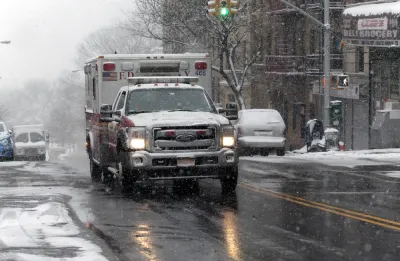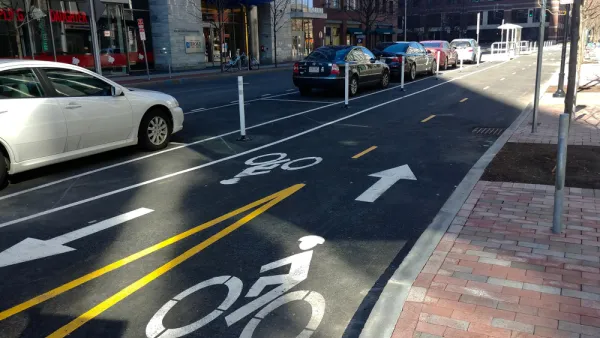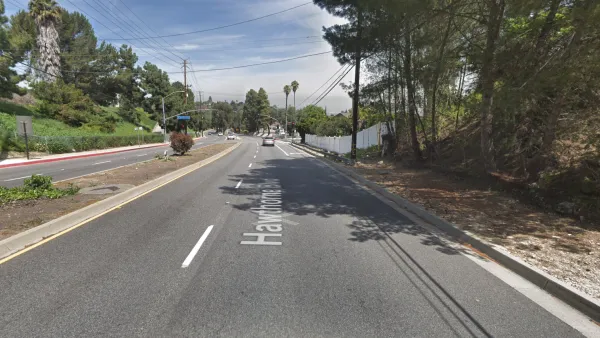Road safety advocates, particularly those who promote walking and biking, have long understood the importance of language, such as using "crash" rather than "accident." Two new media studies shed more light on bias in media coverage of crashes.

Cyclist deaths are on the rise. "In 2017 (the last full year for which we have data), 783 were killed on the roads [according to the Fatality Analysis Reporting System (FARS) of the National Highway Traffic Safety Administration] —continuing the upward trend of the past decade," writes Joe Lindsey for Outside Magazine. "Amid an all-time high of vehicle miles traveled, pedestrian and motorcyclist deaths were also at all-time highs, even as fatalities among car occupants have dropped by more than 30 percent over the last 25 years."
Almost as troubling as the rise in deaths is the media coverage of these crashes. ... News stories often play a key role in shaping public understanding of traffic safety. And when news stories victim-blame or fail to convey the larger context in which these crashes take place, they do deep injustice to the victims and the conversation about road safety in general.
I personally have been aware of the "crashes are not accidents" safety campaign that originated at the National Highway Traffic Safety Administration in 1997. Lindsey examines two recent academic studies that find there's much more to question about how the media cover traffic safety issues when they involve the deaths of "vulnerable road users," e.g., pedestrians, bicyclists, and motorcyclists.
"Editorial Patterns in Bicyclist and Pedestrian Crash Reporting," written by Kelcie Ralph (Rutgers), Evan Iacobucci (Rutgers), Calvin G. Thigpen (Arizona State), and Tara Goddard (Texas A&M) was published on Feb. 8 by the Transportation Research Board. A study from the University of South Florida’s Center for Urban Transportation Research (CUTR) is due to be published soon by the TRB as well.
The aim of the former study "is to examine local news coverage of vehicle crashes involving someone walking or biking," states the abstract (additional viewing requires payment/subscription). "To that end, this paper used content analysis of 200 local news articles to answer the research questions:"
- How do articles apportion blame between vulnerable road users (VRUs) and drivers? The results reveal that local news coverage tends to shift blame toward VRUs and away from drivers.
- To what extent do articles frame crashes as a public health issue? Coverage almost always treats crashes as isolated incidents, obscuring the public health nature of the problem.
The abstract is limited, but fortunately, Lindsey does a thorough job of delving into the findings of both studies. "[J]ournalists are prone to questionable phrasing, and even making flat-out mistakes, when reporting on these crashes," he writes. Two examples of the former, in addition to the use of "accidents" to describe crashes (which even the Associated Press cautions against), follow:
- The use of passive, clinical language that reduced the human role in the crash. “Sometimes the story would say that the person was hit by a car, which is passive,” says co-author Tara Goddard, an assistant professor of urban planning at Texas A&M. This language distances the driver’s actions from the crash. “To say an object with no capability on its own actively hit a cyclist is hilarious phraseology,” says Megan Hottman, a Colorado lawyer who represents cyclists hit by drivers.
Lindsey is careful to use driver, rather than car, SUV, or vehicle, in describing the parties involved in a crash.
- The studies also looked at whether reports contained what the researchers called a counterfactual: a detail that subtly shifts blame, such as noting that the victim “was not wearing a helmet” or “was wearing dark clothing.” In the university group’s study, 48 percent of the examined stories included such a statement, which, without important context, suggested the victim was at least partly at fault. “Dark clothing is irrelevant if the driver is distracted,” says Goddard, “and a helmet will not save you if the driver hits you at 60 miles per hour.”
Role of urban planners
The abstract of the "editorial patterns" study points to the importance of urban planners working with journalists in reporting crash details that will help frame bike and pedestrian crashes as the public health issue they are rather than isolated incidents "and increase public pressure to reduce road deaths."
None of the 200 articles reviewed by the researchers "featured comments from the crash victim or road-safety experts like urban planners," notes Lindsey.
Related in Planetizen:
-
Bike Fatalities Rising Quickly, September 6, 2017
-
Does it Matter if We Call Crashes 'Accidents'? August 25, 2015
Hat tip to CityLab Daily.
FULL STORY: How We Talk About Drivers Hitting Cyclists

National Parks Layoffs Will Cause Communities to Lose Billions
Thousands of essential park workers were laid off this week, just before the busy spring break season.

Retro-silient?: America’s First “Eco-burb,” The Woodlands Turns 50
A master-planned community north of Houston offers lessons on green infrastructure and resilient design, but falls short of its founder’s lofty affordability and walkability goals.

Delivering for America Plan Will Downgrade Mail Service in at Least 49.5 Percent of Zip Codes
Republican and Democrat lawmakers criticize the plan for its disproportionate negative impact on rural communities.

Test News Post 1
This is a summary

Test News Headline 46
Test for the image on the front page.

Balancing Bombs and Butterflies: How the National Guard Protects a Rare Species
The National Guard at Fort Indiantown Gap uses GIS technology and land management strategies to balance military training with conservation efforts, ensuring the survival of the rare eastern regal fritillary butterfly.
Urban Design for Planners 1: Software Tools
This six-course series explores essential urban design concepts using open source software and equips planners with the tools they need to participate fully in the urban design process.
Planning for Universal Design
Learn the tools for implementing Universal Design in planning regulations.
EMC Planning Group, Inc.
Planetizen
Planetizen
Mpact (formerly Rail~Volution)
Great Falls Development Authority, Inc.
HUDs Office of Policy Development and Research
NYU Wagner Graduate School of Public Service





























